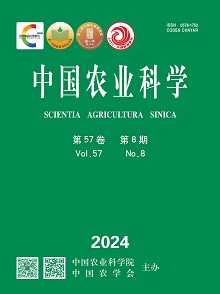【Objective】 Global seasonal high temperature and drought have become the main limiting factors affecting crop growth and development as well as yield formation. Based on artificial simulation of the climate characteristics of periodic high temperature and drought stress, the effects of high temperature stress, drought stress and the combined stress of high temperature and drought during the flowering stage on morphological development and physiological characteristics of tassel and yield formation of summer maize were explored in this study. 【Method】 The experiment was conducted by pot-experiment in the greenhouse with intelligent control system for two years. Zhengdan 958 (ZD958) and Huanong 138 (HN138) were used as the experimental materials. The four treatments of control (CK), flowering high-temperature stress treatment (T), flowering drought stress treatment (D) and flowering high-temperature-drought combined stress treatment (TD) were set up to study the tassel morphology, anther and pollen structure, pollen viability, tassel antioxidant index and yield of summer maize in response to high temperature and drought during flowering stage. 【Result】 High temperature, drought and combined stress resulted in significant reduction in the tassel branch number, tassel central branch spikelet number and tassel branch spikelet density in maize, and these three parameters of T treatment were 17.31%, 15.70% and 13.56% lower than that under CK, respectively; D and TD treatments were 33.85%, 24.87%, 27.08% and 45.59%, 32.02%, 26.00% lower than CK, respectively. Drought and combined stress significantly shortened tassel central branch length by 23.64% and 27.51%, respectively, compared with CK. High temperature stress and drought stress at flowering stage led to anther shrinkage and deformation, loose arrangement of tapetum cells, and reticular protrusion on pollen grain surface. Combined stress aggravated anther shrinkage and deformation, broken of tapetum cells. And the septal vascular bundles became thinner, the number decreased, the reticular protrusion of pollen grains was more obvious, and the germination holes were invaginated under combined stress. High temperature, drought and combined stress significantly reduced the dispersed amount of pollen in tassel, and the dispersed amount of pollen under T, D and TD treatments was 22.18%, 54.75% and 67.28% less than CK, respectively. The date of maximum dispersed amount of pollen was earlier than that under CK. T, D and TD treatments significantly reduced the proportion of highly vigorous pollen compared with CK. T treatment increased the activities of SOD and POD enzymes in the tassel by 21.91% and 32.50%, respectively, compared with CK; While those under D and TD treatment increased by 24.95% (SOD), 53.37% (POD) and 17.12% (SOD), 67.24% (POD), respectively, compared with CK. The MDA content in the tassel under T, D and TD treatment increased by 44.18%, 64.24%, and 79.12%, respectively, compared with CK; The $\mathop{{O}}_{2}^{{\mathop{}_{\ •}^{-}}}$ content increased by 22.55%, 51.65%, 72.29%, respectively, compared with CK. High temperature, drought and combined stress reduced maize yield and grain number per row by 18.05%, 34.58%, 46.24% and 24.58%, 41.80%, 52.99%, respectively, compared with CK. Under stress treatment, the tassel branch number, the tassel central branch spikelet number and the tassel branch spikelet density of HN138 were decreased by 27.00% and 17.28%, respectively, compared with ZD958; The distortion degree of anther and pollen structure of HN138 was higher than that of ZD958, and the increase of antioxidant enzyme activity was less than that of ZD958, but MDA and O2 ·-content were 13.07% and 20.29% higher than that of ZD958. HN138 was more sensitive to high temperature, drought and combined stress between two cultivars. 【Conclusion】 The results showed that high temperature, drought and combined stress significantly inhibited the growth and development of tassel, led to the distorted morphological structure of anther and pollen, reduced the dispersed amount of pollen, decreased the activity of antioxidant enzymes, and inhibited the normally pollination and fructification, thus resulting in the decreased kernel number and grain yield. The effect of combined stress of high temperature and drought on tassel was greater than that of single stress, but the response of different varieties to high temperature and drought was different.











